What you have is the wires to the device that makes 4 chuffs per revolution of the wheels. It could be that somewhere along the line during battery conversion wires have been added or reworked from the too that makes ypthis difficult to removed. my thoughts are why not just leave it as a battery loco? There is always some benefit to having at least one loco that does not require track power and could this be the one for you?Hi all,
Here is a video of the issues I'm running into attempting to pull this beasty apart!
You are using an out of date browser. It may not display this or other websites correctly.
You should upgrade or use an alternative browser.
You should upgrade or use an alternative browser.
how to access motor on Bachman Spectrum 4-4-0 American (circa 2000)
- Thread starter rpiboy01
- Start date
Rhinochugger
Retired Oik
Go back to Greg's video and you can see the difference. The two chuff sensors are not sticking up in the same way - I think they should be laying flat under the axle.. It's just out of shot on my picture but the loco is still laying on its side in da shedHi all,
Here is a video of the issues I'm running into attempting to pull this beasty apart!
EDIT
Ah, no, helpfully unhelpful - on my loco the chuff sensors come up the front of the axle like yours.
So, I reckon it's time to get the small screwdriver out and give things a tweak. I can't think that there is anything that is intended to be there that you can break if you attack it gently
Last edited:
Fred2179G
Registered
Hi Robert,Here is a video of the issues I'm running into attempting to pull this beasty apart!
I've pulled a few of these apart, so let me offer a few observations. The bottom plate is only prevented from lifting out by the wires from the chuff fingers, that you identified on your video. Just pull it straight up. It is possible to break it at the joint where the vertical piece meets the horizontal but last time I looked they were available from Bachmann:
Loco Underframe Brown ( Large 2-6-0 ) [G814X-00T04-87] - $35.15 : Bachmann Trains Online Store!
The fingers for the chuff are attached to the upper portion of this base. Here's a photo of the base almost removed, and the chuff plate is arrowed. You may not be able to get it further out than that due to the wiring from the chuff. The PCB with the 2 orange LEDs is the firebox flicker. I ignored it. The chuff plate wiring just leads out the back to the connector under the tender front. (Marked "sound wiring" on the Bachmann drawing.) You might try pushing the chuff wires from the back of the cab further in to the loco to free them up a bit? On your video there are 2 pairs of wires coming from under the chuff drum/axle, which are not standard - push them further in to the loco and that might free up the chuff plate a bit!
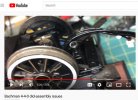
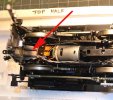
Here's a pic of the bearings and wires after the axles came out. You don't need to do this unless your gear is cracked. At the top is a bearing with 2 white wires and the bottom has 2 green ones. (You can also see the holes that fit the springs under the bearings - on top when it is right-way up!)
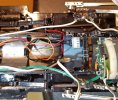
The circuit board on the back of the motor is, I believe, for DCC interference suppression. I think I have read that you can remove it. Greg?
I did manage to fix mine without buying a new one. Here's the pic of the small bracket I made and glued and screwed to the bottom plate.
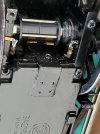
On this photo you can also see the electrical connections to the hornblocks/bearings. I imagine yours have been snipped as I don't see any on your video. What you have to do is wire the 2 pairs of bearings together and then lead the wires up into the boiler to connect with the main PCB. Or, if you can't get that out, wire them direct to the motor.
Under the blocks/bearings is the spring. Here's one that wasn't replaced correctly:
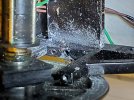
You can lift the wheel gently and replace the spring with a pair of tweezers.
Last edited:
Fred2179G
Registered
As has been mentioned, the tender has copper fingers on the frames to collect power. You can certainly make some new ones, or buy new trucks from Bachmann, as we did recently. On the second pic you can see the wires that are fed through the holes in the truck. (There are other ways to run them - Tim crossed his to avoid the right angle bend.)
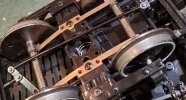
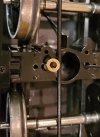
Finally, the 4-pin connector has tender power and 2 unused pins, which I think are for feeding sound from a DCC chip in the loco to the tender speaker, used on the later 2-6-0?


Finally, the 4-pin connector has tender power and 2 unused pins, which I think are for feeding sound from a DCC chip in the loco to the tender speaker, used on the later 2-6-0?
Last edited:
Greg Elmassian
Guest
Nice helpful pictures!
Yes I would remove the noise suppression board, which is there to reduce RF interference cause by the motor (irrespective of how it is powered). DCC is sometimes especially sensitive for a different reason, the components can "fool" some of the BEMF circuitry on some decoders, and cause strange running.
Also, the components on that board sometimes burn up/short out... just something else to go wrong.
Greg
Yes I would remove the noise suppression board, which is there to reduce RF interference cause by the motor (irrespective of how it is powered). DCC is sometimes especially sensitive for a different reason, the components can "fool" some of the BEMF circuitry on some decoders, and cause strange running.
Also, the components on that board sometimes burn up/short out... just something else to go wrong.
Greg
Fred2179G
Registered
By accident, I was co-operating with Tim over the other side of town, dealing with a 2-6-0 and two of the 4-4-0s for the past few months, Pics were useful when trying to explain what I was doing to him. I wrote up a thread on MLS and LSC "A tale of two 4-4-0s".Nice helpful pictures!
Yes I would remove the noise suppression board
Here's a pic I thought I had posted, of the chassis with the motor out. Again, this is only necessary if you are replacing the gear. And the bottom frame is usually still attached at the chuff wires - this is the 2-6-0 with the broken chuff plate that you can see near the drawbar! If you look closely you can see the motor wires disappear into the frame (and then to the main PCB,) and the pickups also go into the frame and to the PCB. All the latter does is send power to the lights, smoke, etc., unless you have the latest 'DCC Ready' 2-6-0 version.
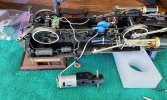
Here's another very useful thread about disassembly - How to replace the gear:
Bachmann Forum
rpiboy01
Registered
I have no battery packs as it did not come to me with any. So yes, I could buy batteries, but then I need to also buy a charger and do all the neccessary research (started a new thread on this topic in fact). However, I do have plenty of power supplies, so now my investment is time and no capital. I'm a DCC guy and while I've continued to read about dead rail, WiFi control, DCC over WiFi etc. I'm still pretty comfortable with putting voltage on the rails. I regularly operated on the SJRP&Ry which uses Lenz with generally good results. I also have spare DCC boosters, command stations and controllers, so then if I'm making a capital investment I'm buying decoder(s) and wire.why not just leave it as a battery loco? There is always some benefit to having at least one loco that does not require track power and could this be the one for you?
To each his own right?
rpiboy01
Registered
As has been mentioned, the tender has copper fingers on the frames to collect power. You can certainly make some new ones, or buy new trucks from Bachmann, as we did recently. On the second pic you can see the wires that are fed through the holes in the truck. (There are other ways to run them - Tim crossed his to avoid the right angle bend.)
Cheers,
-Robert
Fred2179G
Registered
I find the chains a pain, so I am very happy when they fall off so I can remove them all.the bigger issue I think will be removing the chains so that I can remove the trucks to work on them.
You can remove the truck sideframes without taking the trucks off - see the end of the first post of this thread:
Bachmann Spectrum 4-4-0/2-6-0 Tender truck fix
And btw, you should think about doing this tender truck sideframe modification.
Fred2179G
Registered
Can I recommend phosphor-bronze for wipers? It is springier and retains its springiness longer than brass. I think you can get sheets of it on Amazon. (I have a lot of p-b wire sold as trolley wire that I bought 30 years ago.)I have some lightweight brass sheet
rpiboy01
Registered
So Christmas caught up with me and had to set it all aside. Gave up on trying to get the loco apart. Did manage to get the spring back in place even with the driver wheel in the way.I think you're in a similar place to where I was - so take the bull by the horns and dismantle the loco completely. You'll then be able to see the PCBs quite easily, and steadily put things back together the way you want them.
It's not as difficult as it sounds - the 4-4-0 is one of the easier Bachmann locos to take apart ........................... and re-assemble

Thanks for confirming easy removal of the chains. I have now started fashioning some wipers out of some brass sheet stock I had on hand. Wondering if I should reduce the contact area further in order to reduce drag, thoughts?
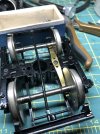

Fred2179G
Registered
Nice work. I wouldn't think the contact area will matter too much as you are in the center of the wheel.Wondering if I should reduce the contact area further in order to reduce drag, thoughts?
Greg Elmassian
Guest
Physics will tell you that the drag is the same no matter what the contact area.
Physics will also tell you the larger the contact area, the lower the current density so the less "burning" of contacts due to the heating spread over a larger area.
Greg
Physics will also tell you the larger the contact area, the lower the current density so the less "burning" of contacts due to the heating spread over a larger area.
Greg
Rhinochugger
Retired Oik
You can adjust the drag by the pressure on the axle - i.e. tweak and bend if necessary. A decent weight in the tender helps with pick up from wheel to track (Greg taught me that).So Christmas caught up with me and had to set it all aside. Gave up on trying to get the loco apart. Did manage to get the spring back in place even with the driver wheel in the way.
Thanks for confirming easy removal of the chains. I have now started fashioning some wipers out of some brass sheet stock I had on hand. Wondering if I should reduce the contact area further in order to reduce drag, thoughts?
View attachment 294284
View attachment 294285
Fred2179G
Registered
Yes, but physics will also tell you that fixed drag on a wheel at the rim has more effect than the same drag close to the center of the wheel, as the drag occurs for a shorter distance.Physics will tell you that the drag is the same
Greg Elmassian
Guest
OK, so?
Is he moving the contact from the axle to the tread? I did not read that. And the reason not that the drag occurs for a shorter distance, but the moment arm is longer in the case of tread pickup... IF you do know physics.

So, given the contact is on the hub of the wheel as pictured, no reason to reduce the size of the contact patch, all it will do is accelerate wear, since the normal force per area is increased (same total force over a smaller area)
Greg
Is he moving the contact from the axle to the tread? I did not read that. And the reason not that the drag occurs for a shorter distance, but the moment arm is longer in the case of tread pickup... IF you do know physics.
So, given the contact is on the hub of the wheel as pictured, no reason to reduce the size of the contact patch, all it will do is accelerate wear, since the normal force per area is increased (same total force over a smaller area)
Greg
Greg Elmassian
Guest
Grease will help lower friction and keep oxidation more at bay on both parts.
JimmyB
Now retired - trains and fishing
But surely grease in NOT conductive, so will reduce or even eliminate the contact usability.Grease will help lower friction and keep oxidation more at bay on both parts.
rpiboy01
Registered
Electronic grease is. I've got some LPS1 I could coat it with as well as some deOx. Was planning to put some on it anyway. I've started treating my HO scale track with LPS1 and was planning to conduct some experiments with larger scale track and real weathering. I also have some old track that has been outside for the better part of a decade (unused) that I was going to attempt to clean-up and see how it performs.But surely grease in NOT conductive, so will reduce or even eliminate the contact usability.
